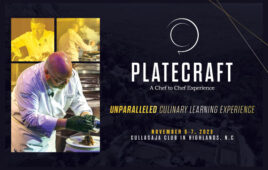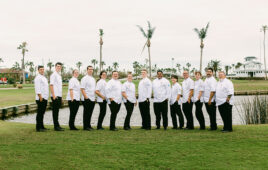 Let’s be honest among ourselves, as club chefs. How many of us have put "Vegetarian Options Available on Request" on our menus, before we’ve really put a lot of thought or effort into just how many truly interesting options we’re going to be able to provide when those requests are made? Or how many of us have had to search, a few hours before a wedding, to find something interesting to serve the half-dozen vegetarians we’ve been told will be attending?
Let’s be honest among ourselves, as club chefs. How many of us have put "Vegetarian Options Available on Request" on our menus, before we’ve really put a lot of thought or effort into just how many truly interesting options we’re going to be able to provide when those requests are made? Or how many of us have had to search, a few hours before a wedding, to find something interesting to serve the half-dozen vegetarians we’ve been told will be attending?
While vegetarians still only make up a small percentage of the dining public (most estimates put the figure at somewhere between 2 and 5%), we’ve all had members contact us and say "I have a vegetarian guest—what can you do?" How we respond in these situations is not only important to the people we’ll be serving, but equally important—if not more so—to the member-host who wants to know that their needs can be met.
As I’ve encountered these situations at my club, I’ve made a concerted effort to handle them in a more efficient and effective manner. I now make three vegetarian options available for catered functions that can be discussed with clients at meetings or tastings. And a new vegetarian dish now rotates through both our casual and formal menus on a weekly basis.
Other club chefs tell me they’ve recognized the need to do the same thing, in the interest of truly providing good and complete service to all members and guests. To help us all do a better job in this area, I thought it would be valuable to speak with a colleague who’s a real expert: John Nowakowski, Executive Chef at The Regency Resort and Spa in Hallandale, Fla.
John has been creating innovative vegetarian cuisine for over 13 years. He is the author of "Vegetarian Magic at The Regency House Spa" and has another book in the works. He’s been a frequent speaker at places like Whole Foods and Borders, and a national spokesperson for Boca Foods (which makes Boca Burgers and other soy-based meat and poultry alternatives).
 |
| John Nowakowski, Executive Chef at The Regency Resort and Spa in Hallandale, Fla. |
John’s recipes have helped many chefs learn to take a new and expanded approach to heart-healthy and low-fat cuisine. I was pleased to have this opportunity to get his insights into an area that is often overlooked or shortchanged.
Q Chef, every year a foodborne illness hits the news, with fruits and vegetables usually the culprits—the latest example being the recent tomato scare. As someone who depends even more than most on using these ingredients, what steps do you take to ensure food safety at The Regency?
A Every food operation must have a manager on staff who has attended the Food Certification Course and passed the exam. It also needs renewing every five years. So I am always up to date with the standards. Then I quiz and certify our employees as well.
We also wash all of our produce. Conventional produce that has been known to be an especially high recipient of pesticide spraying, such as apples and berries, is washed with a special produce spray, "Veggie Wash," which is basically citric acid. You spray it on produce, agitate and rest for 30 seconds, then rinse it off. It will remove all water-soluble herbicides, pesticides and fungicides.
Did you know that a typical apple has been touched by five different people, and a tomato by up to 30 people, before they get to us? So we need to make sure we are washing off all human bacteria.
Our employees wear rubber gloves whenever hand-mixing a salad or entrée. Hair nets where applicable is a rule. A convenient hand-washing station and Purell sanitizers in the restrooms are also musts.
Q Club chefs are always looking for signature items, and lunch entrée salads are hugely popular items—what are the most popular lunch entrées at The Regency?
A We always have a full salad bar, but not everyone wants to eat "raw" all the time, so we have soup ‘n salad twice a week. These are not your average soups that are roux-thickened or have MSG-flavored chicken bases. We thicken naturally with veggies and potatoes, and flavor with organic, GMO-free miso.
Other days we do whole-wheat pita sandwich bars with fresh-made hummus made from organic legumes. Our Sunday brunch will have "tofu egg salad," tempeh tuna salad, sprouted wheat bagels with scrambled tofu, oven-baked sweet potato home fries, and of course, every salad bar has Chef John’s Famous Tahini Dressing.
Q What kind of volume does the Regency do?
A We average about 65 covers per meal period, in season. Keep in mind, we only have 60 rooms and are not a free-standing restaurant; you must stay here or be in a day program to participate. We have a 60% guest return rate, which speaks well not only for our cooking, but also the natural hygienic health program that we offer, not to mention our beautiful, semi-private beach on the warm, blue Atlantic Ocean.
Q How much of your total food costs are accounted for by fruit and vegetable purchases?
A Produce accounts for about 70% of my total food purchases. Breakfast is my most expensive meal period, which is quite different from a typical hotel restaurant.
Q You’ve been a national spokesman for a leading brand of soy-based alternative products—for those who are not as familiar with them, what specific items should club chefs look at to enhance the heart-healthy parts of their menus?
A There are soy-based products that can be excellent meatless options for dishes like chili, shepherds pie, Bolognese sauce and even as veggie offerings for kids’ menus. At the Regency, I would estimate I have served over 25,000 soy burgers.
Q What are some positive financial aspects to vegetarian cooking chefs might not be aware of?
A I continue to believe it is not only healthier, but cheaper, to buy organic, protein-rich legumes, grains like quinoa, barley, millet, and basmati brown rice, and soy products that can be used as needed to provide alternatives for things like U–15 shrimp, Angus beef and veal loin. This only stands to become more true, I think, as rising fuel prices continue to affect farming and transportation costs.
Another interesting benefit that you might not think of is that when we were hit by multiple hurricanes a few years back and the entire region was without electricity for weeks, I had no problem with spoilage. While everyone else was trying to eat all the thawing meat and seafood from their freezers before it went bad, at The Regency we just kept on cooking our dry organic legumes and grains with gas burners, and never missed a beat in the kitchen.
Q I know your cookbook, "Vegetarian Magic," is something you are very proud of. For those of us who’ve always wanted to do a cookbook, how much time and effort goes into a project like that?
A It’s a lot of work, but if you do it as you go along, it will write itself over time. As a successful chef, there will always be someone in your restaurant who will want a recipe. When I started at the Regency 13 years ago, not a day went by when someone didn’t ask for one. So I would go home and every morning try to write a new recipe. Next thing you know, I was halfway into a cookbook.
At that point I finally made good use of my English classes in school and created an outline and chapters, and off I went. It took me about nine months to write my first book. It also helps that my style is to use the "Keep It Simple, Stupid" (KISS) approach to cooking, so my recipes won’t be intimidating to anyone who is new to cooking this way.
Q Finally, can you talk about the "Shopping Smart" program you conduct for resort guests?
A Every Wednesday evening, we drop our guests off at the local Whole Foods store. Beforehand, I do a class titled "Shopping Smart," and I discuss how to take a "healthy trip" through the supermarket that includes explanations of the meaning of enriched foods, transfat-free products, low-glycemic sweeteners, and better convenience food choices. Basically, it’s a soup-to-nuts explanation of healthier choices for people who are in transition to a healthier diet. C&RB




